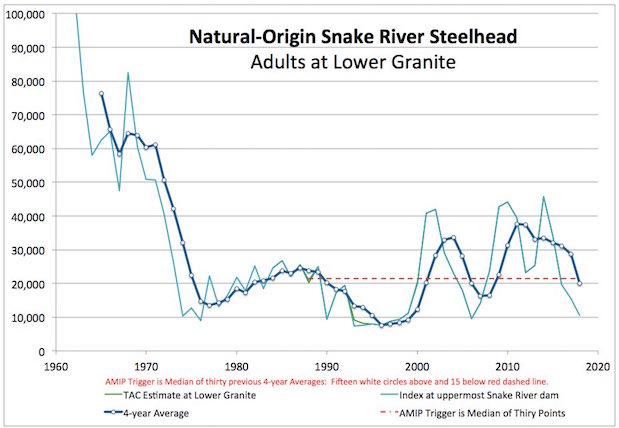forum
library
tutorial
contact

ODFW says Average Catch Time for Steelhead
in Northeast Oregon is About 10 Hours
by Staff
East Oregonian, November 2, 2019
|
the film forum library tutorial contact |

|
ODFW says Average Catch Time for Steelhead
by Staff
|
Support your fish with two wet hands and return it to the water as quickly as possible.
Ten seconds of air exposure can cause serious problems for fish.
 ENTERPRISE -- Prized by anglers for its beauty, challenge and raw bursts of power, the Pacific steelhead is referred to in fishing lore as the "fish of a thousand casts." For those fishing local steelhead streams like the Grande Ronde, Wallowa and Imnaha rivers this year, it might be more like the fish of 27 hours.
ENTERPRISE -- Prized by anglers for its beauty, challenge and raw bursts of power, the Pacific steelhead is referred to in fishing lore as the "fish of a thousand casts." For those fishing local steelhead streams like the Grande Ronde, Wallowa and Imnaha rivers this year, it might be more like the fish of 27 hours.
That's currently about how much time an average angler will fish before bringing a steelhead to hand, based on local river surveys being done by the Oregon Department of Fish and Wildlife. Ten hours per fish is pretty decent steelheading around, according to ODFW Acting District Fish Biologist Kyle Bratcher in Enterprise, with exceptional years being closer to five hours per fish or even fewer.
"For the most part it's been pretty slow," Bratcher said, "We're not seeing great catch rates."
There's no magic formula to solving this year's steelhead fishing. It boils down to numbers -- there just aren't very many fish around.
"We're definitely running behind what we were last year," Bratcher said, "and last year wasn't a good year either."
Local businesses focused on fishing find themselves running behind too. Brad Snook, owner of the Sports Corral in Joseph, says receipts on fishing licensing are running about 40% of normal for this time of year.
With an estimated 85% of this year's hatchery steelhead run past Lower Granite Dam on the Lower Snake, ODFW estimates that fewer than 3,000 are heading back to a Grande Ronde or Imnaha basin hatchery facility. In the 2014-15 season, the total of hatchery arrivals was closer to 12,000.
ODFW does not normally project wild steelhead returns to the Grande Ronde and Imnaha basins, but said a rough estimate would be about 25% of the wild steelhead total crossing Lower Granite headed for the Grande Ronde Basin, and about 8% headed to the Imnaha. With 10,866 "unclipped," meaning presumably wild, steelhead past Lower Granite so far this year, that estimate would have about 2,717 headed for the Grande Ronde and 869 Imnaha-bound. Notably, total counts at Lower Granite show hatchery steelhead outnumbering wild fish by nearly 2-to-1. With numbers that low, all wild steelhead caught must be released.
Fish populations overall in the Grande Ronde, Wallowa and Imnaha rivers are co-managed by the Nez Perce Tribe, the Confederated Tribes of the Umatilla Indian Reservation, and the fish and wildlife departments of Oregon, Washington and Idaho. For his district the decision of whether or not to have a sport steelhead season falls to Bratcher. As of now, the answer is yes, there will be a season.
"Numbers are looking like we can still support a fishery," Bratcher said.
His decision must ensure that enough adult hatchery steelhead return to hatchery facilities to produce the next generation. That means that about 600 fish, total, must return to the Wallowa and Imnaha hatcheries. It's also important to reduce impacts to wild steelhead from fishing. The daily bag limit of three hatchery fish per person has been reduced to one. As in past years, anglers must stop fishing once they reach their bag limit
"A one-fish limit is one of the most conservative strategies besides just closing the season," Bratcher said. "By having a one-fish limit it actually gets people off the river quicker."
Reducing angler time on the river will limit the number of wild steelhead caught, handled and released, Bratcher said, reducing mortality among those fish. Bratcher said an estimated 5% of steelhead caught and released will die. How the fish is handled can swing that number significantly either way. Landing fish quickly, leaving them in the water, handling using wet hands or a rubber net (not nylon) are all good practices. If you want a quick photo, Bratcher said, support your fish with two wet hands and return it to the water as quickly as possible. Ten seconds of air exposure can cause serious problems for fish.
Some wild steelhead advocates would likely argue for a more conservative range of changes in order to reduce or eliminate impacts on wild steelhead from fishing, and from hatcheries, in area rivers. Some might argue for shutting the season down. Other steelheaders might object to the changes already made.
"If we have to go more conservative it'll be to close the season," Bratcher said. "But I don't anticipate that being the case right now. People are catching fish and it's a great time of year to be down on the river," Bratcher said, "a great time of year to be fishing."
Related Pages:
Low Steelhead Numbers Prompt Review by Eric Barker, Lewiston Tribune, 11/5/19
The Grim Outlook for Columbia Basin Salmon and Steelhead by Yancy Lind, Lewiston Tribune, 9/18/19
With A-Run Steelhead Not Living Up to Predictions, Fish Managers Downgrade Forecast by Alan Moore, Lewiston Tribune, 8/31/19
learn more on topics covered in the film
see the video
read the script
learn the songs
discussion forum
